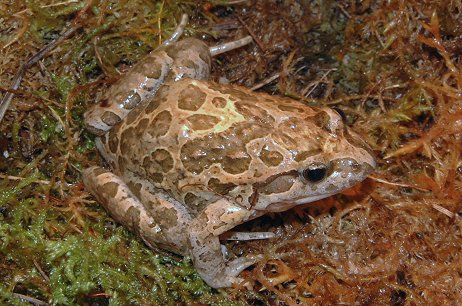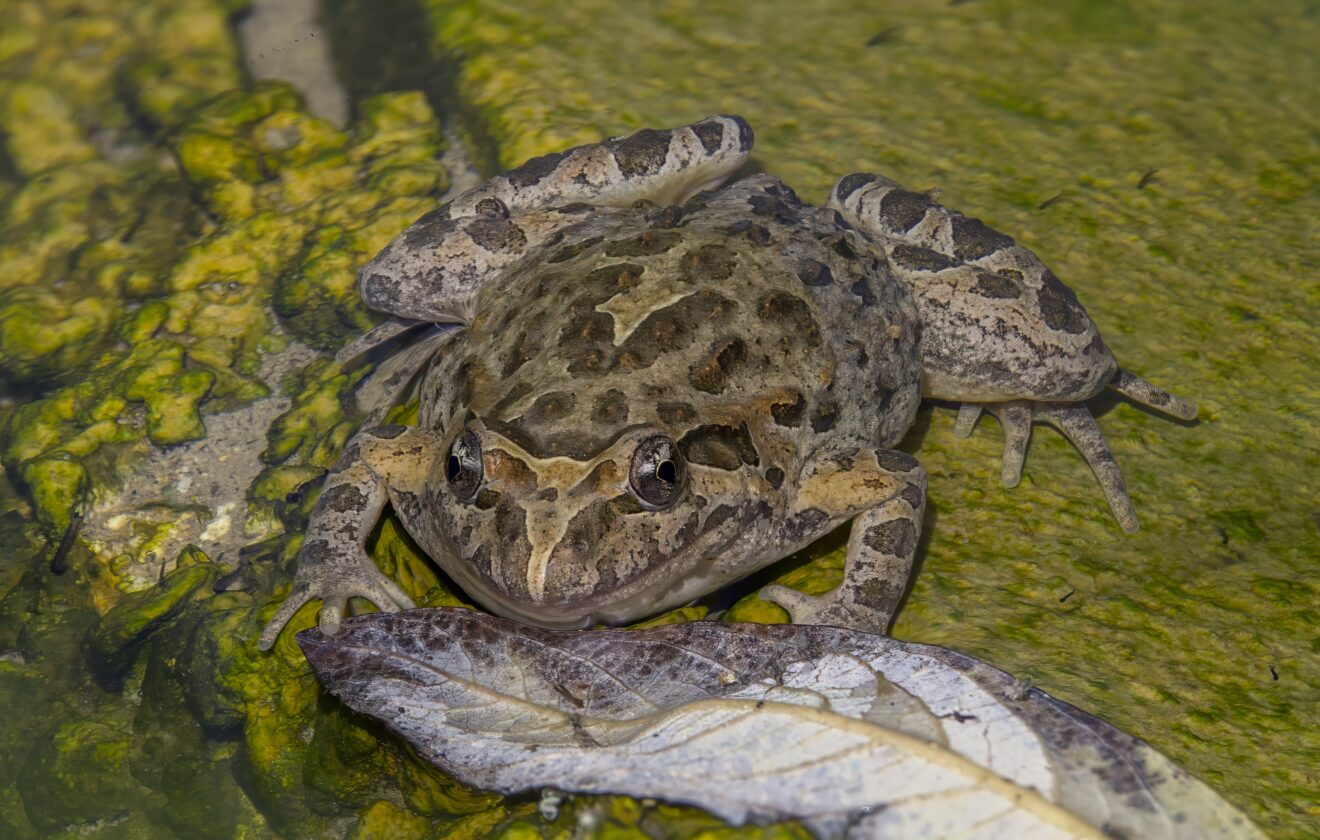Discoglossus pictus: The Painted Frog of the Mediterranean#
Beneath the dappled shadows of Mediterranean woodlands and along gentle streams that ripple through the lush terrains of southern Europe lives a small amphibian whose intricately painted skin has inspired awe and admiration from nature enthusiasts and scientists alike. Meet Discoglossus pictus, commonly known as the Mediterranean Painted Frog. Characterized by a mottled complexion that mirrors the beauty of nature’s colors, this modest yet remarkable amphibian hides quietly in plain sight, harmoniously blending life and landscape in its delicate markings.
The Painted Frog’s life remains intricately woven into its habitat, serving as a subtle indicator of the ecological health of its environment. Beyond being just a beautiful creature, it is an integral player, acting both as predator and prey, skillfully navigating the series of relationships within its ecosystems. Dive with us into the intriguing life of the Discoglossus pictus, where quiet pools, careful ambushes, and elaborate courtships await in verdant landscapes.
Taxonomy and Classification#
Belonging to the family Alytidae, the Mediterranean Painted Frog is scientifically named Discoglossus pictus. It is part of the anuran group, which includes frogs and toads characterized by their tailless adulthood and extraordinary metamorphosis from tadpole to adult. Within its genus, Discoglossus, the Painted Frog shares lineage with several closely related species distributed across southern Europe and North Africa.
This genus, often referred to as ‘Disc-tongued frogs’ for their uniquely shaped tongues, evolved under very particular Mediterranean climatic conditions. Among its close relatives, Discoglossus sardus from Sardinia and Discoglossus montalentii from Corsica exhibit similar adaptive traits, yet subtle variations in coloration and habitat preference distinguish each species. Such comparative studies of relatives like these have enriched our understanding of how subtle ecological variations sculpted distinct adaptations in amphibian populations across the Mediterranean region.
Natural Habitat#
The Mediterranean region is famed for its warm climate, distinct seasons, and diverse habitats—from coastal dunes and marshes to deciduous forests and rocky, mountainous terrains. Here, within this ecological tapestry, Discoglossus pictus finds refuges that align closely with its terrestrial and semi-aquatic needs.
Geographic Distribution#
Naturally found across Mediterranean biomes, Discoglossus pictus populations flourish along Italy’s western coastline, Sicily, Malta, southern France, and even parts of eastern Spain, including the Balearic Islands. Additionally, human-mediated introductions into new localities like southwestern France have allowed researchers intriguing glimpses into its adaptive prowess when faced with unfamiliar ecosystems.
Habitat Preferences and Ecology#
A frequent resident of riparian zones, this frog especially favors damp habitats—streams, pools, small rivers, irrigation ditches, and temporary ponds formed by seasonal rains. Mild temperatures, ample moisture availability, and the presence of dense shoreline vegetation provide optimal shelter from potential predators and drying conditions. Within these environments, the painted frog carefully balances its moisture-rich skin condition, often hiding beneath stones, leaves, or moist earth during daylight hours, emerging at twilight for nocturnal activity.
Physical Characteristics#
True to its name, the Mediterranean Painted Frog features intricate and varied patterns across its modest body size, typically reaching lengths between 5–7 centimeters. Exhibiting a rich palette emphasizing earth tones—olive-green, light brown, grey, and occasional ochre hues—this subtle blend of colors and patterns integrates seamlessly with the surroundings.
The frog’s coloration is not merely ornamental; rather, it plays a pivotal role in the frog’s survival through exceptional camouflage. Dappled patterns and irregular blotches along its back and flanks break up outlines effectively, confusing predators visual acuity and creating the perfect cryptic coloration suited to environments accented by leaf litter and mossy stones.
Alongside these effective color adaptations, Discoglossus pictus demonstrates powerful hind limbs, well-developed for springing leaps and swift, precise movements required for escape or prey capture. Their slightly flattened, robust bodies aid in traversing ground cover with ease, while moist, smooth skin continually absorbs oxygen from their environment, vital for supplementing their conventional respiration.
Behavior and Life Cycle#
The life of a painted frog unfolds as a series of rhythmic behavioral patterns, seamlessly synchronized with their surrounding environment’s natural cycles. As nocturnal hunters, their nightly activities primarily include foraging along the edges of water bodies, forests, and grasslands.
Feeding and Hunting Behavior#
A nighttime observer might glimpse the subtle gleam of eyeshine as a painted frog patiently stalks its prey. Dietarily opportunistic, adult Discoglossus pictus consume invertebrates such as insects, small spiders, and mollusks, grasped swiftly by their uniquely disc-shaped tongues and gulped down whole. Hunting itself is often an exercise in stealth and sudden bursts of movement—the frog remaining motionless for extended periods, then snapping forward with precision at unsuspecting prey.
Reproduction and Development#
Perhaps no other behavior in the painted frog’s repertoire matches the vibrancy and complexity of its breeding season. Typically occurring from late winter through spring, male painted frogs gather in shallow waters by night, emitting soft, melodic calls reminiscent of gentle ‘clicks’ or short knocking sounds. Modest compared to louder amphibians, these choruses nonetheless resonate beautifully in quiet moonlit environments.
Females, attracted by these serenades, join prospective mates in shallow pools. After courtship sessions, female frogs deposit hundreds of gelatinous eggs, singly or in small clumps, attaching them to submerged vegetation or leaf litter. The clear, jelly-like egg masses incubate in tepid water, and within days, tiny tadpoles emerge, swiftly adapted to aquatic life.
Tadpoles initially survive by feeding on algae, microscopic organisms, and detritus. Gradually they develop limbs and lungs, with the fascinating metamorphosis completing within a few months. Emerging juveniles soon embark upon their terrestrial lives, uniquely adapted for a semi-aquatic existence.
Ecological Role#
Though modest and elusive, the painted frog provides critical ecological services within Mediterranean habitats. As an opportunistic predator, it controls pest insect populations, thereby contributing to environmental balance. Simultaneously, these frogs form a crucial prey base supporting diverse predators—herons, snakes, fish, mammals, and even larger amphibians.
Discoglossus pictus also serves as an ecological barometer, signaling ecosystem health and stability. Amphibians in general, sensitive to environmental perturbations, indicate changes in water quality, climate patterns, and habitat degradation rapidly—precisely why conservationists closely monitor painted frog populations across the Mediterranean basin.
Threats and Conservation Status#
Currently, the Painted Frog holds a status of “Least Concern” according to the International Union for Conservation of Nature (IUCN), due primarily to its extensive and stable populations across much of its native range. Nevertheless, localized threats continue to pressure vulnerable populations, necessitating continued vigilance and proactive conservation measures.
Primary Threats#
Habitat loss and fragmentation from urbanization, agricultural intensification, drainage of wetlands, and alteration of natural waterways adversely impact critical breeding sites. Pollution from agricultural pesticides and fertilizers further contaminates breeding waters, causing population declines locally.
Furthermore, regional climate shifts threaten existing habitats, impacting seasonal rainfall patterns and drying up essential breeding pools prematurely—a growing concern for conservationists seeking sustainable solutions.
Conservation Efforts#
Local conservation practitioners and environmental authorities have placed focus upon safeguarding riparian environments, restoring wetlands, and ensuring intact breeding habitats. Public education and awareness initiatives spread knowledge of amphibian importance among local communities, fostering appreciation and respectful coexistence.
Cultural and Scientific Significance#
Throughout Mediterranean cultures, amphibians bear symbolic resonance, representing transformation, adaptability, and environmental balance. While not as commonly mythologized as other amphibians, the painted frog captures attention through its beauty and grace, subtly symbolizing nature’s sometimes overlooked wonders.
Scientifically, ongoing studies of Discoglossus pictus expand understanding of amphibian ecology, environmental adaptation, and indicator species value. Its stable populations offer valuable comparative insights into climate resilience strategies among amphibians.
Conclusion#
Though humble and elusive, the Mediterranean Painted Frog quietly underpins the delicate ecological harmony of Mediterranean ecosystems through its cryptic lifestyle and varied contributions. By celebrating its unique biology, we reaffirm the value inherent in preserving these remarkable animals and their habitats, ensuring its gentle clicking calls continue enriching the twilight choruses that define the Mediterranean twilight. Let us consciously strive towards responsible stewardship, cherishing the subtle patterns, gentle harmonies, and quiet reminder of interconnectedness embodied by this wondrous painted amphibian, Discoglossus pictus.


















